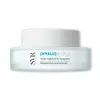What's inside
What's inside
 Key Ingredients
Key Ingredients

 Benefits
Benefits

 Concerns
Concerns

 Ingredients Side-by-side
Ingredients Side-by-side

Water
Skin ConditioningPentylene Glycol
Skin ConditioningIsononyl Isononanoate
EmollientMethylpropanediol
SolventGlycerin
HumectantPentaerythrityl Tetraethylhexanoate
EmollientGlycereth-26
HumectantSilica
AbrasiveCetearyl Alcohol
EmollientButyrospermum Parkii Butter
Skin ConditioningAvena Sativa Kernel Extract
AbrasiveLactobacillus/Rice Ferment Filtrate
Skin ConditioningTetrasodium Tetracarboxymethyl Naringeninchalcone
Skin ConditioningOrnithine
Skin ConditioningHydrolyzed Soy Flour
Skin ConditioningLeuconostoc/Radish Root Ferment Filtrate
AntimicrobialGinkgo Biloba Leaf Extract
Skin ConditioningLevulinic Acid
PerfumingPropylene Glycol
HumectantCetearyl Olivate
Acrylates/C10-30 Alkyl Acrylate Crosspolymer
Emulsion StabilisingAmmonium Acryloyldimethyltaurate/Vp Copolymer
Sorbitan Olivate
EmulsifyingCetyl Alcohol
EmollientPropanediol
SolventChondrus Crispus Powder
AbrasivePhospholipids
Skin ConditioningGlycolipids
Skin ConditioningP-Anisic Acid
MaskingHelianthus Annuus Seed Oil
EmollientTocopherol
AntioxidantSodium Hydroxide
BufferingEthylhexylglycerin
Skin ConditioningSodium Benzoate
MaskingPotassium Sorbate
PreservativeCI 16035
Cosmetic ColorantParfum
MaskingWater, Pentylene Glycol, Isononyl Isononanoate, Methylpropanediol, Glycerin, Pentaerythrityl Tetraethylhexanoate, Glycereth-26, Silica, Cetearyl Alcohol, Butyrospermum Parkii Butter, Avena Sativa Kernel Extract, Lactobacillus/Rice Ferment Filtrate, Tetrasodium Tetracarboxymethyl Naringeninchalcone, Ornithine, Hydrolyzed Soy Flour, Leuconostoc/Radish Root Ferment Filtrate, Ginkgo Biloba Leaf Extract, Levulinic Acid, Propylene Glycol, Cetearyl Olivate, Acrylates/C10-30 Alkyl Acrylate Crosspolymer, Ammonium Acryloyldimethyltaurate/Vp Copolymer, Sorbitan Olivate, Cetyl Alcohol, Propanediol, Chondrus Crispus Powder, Phospholipids, Glycolipids, P-Anisic Acid, Helianthus Annuus Seed Oil, Tocopherol, Sodium Hydroxide, Ethylhexylglycerin, Sodium Benzoate, Potassium Sorbate, CI 16035, Parfum
Water
Skin ConditioningButylene Glycol
HumectantGlycerin
HumectantPropylene Glycol
HumectantCaprylic/Capric Triglyceride
MaskingAscorbyl Tetraisopalmitate
Antioxidant1,2-Hexanediol
Skin ConditioningC10-18 Triglycerides
EmollientCarbomer
Emulsion StabilisingMaltodextrin
AbsorbentSodium Hyaluronate
HumectantSodium Acrylates Copolymer
Acrylates/C10-30 Alkyl Acrylate Crosspolymer
Emulsion StabilisingCaprylyl Glycol
EmollientParfum
MaskingSodium Hydroxide
BufferingLecithin
EmollientLactobacillus Ferment
Skin ConditioningPentaerythrityl Tetra-Di-T-Butyl Hydroxyhydrocinnamate
AntioxidantSodium Acetylated Hyaluronate
HumectantWater, Butylene Glycol, Glycerin, Propylene Glycol, Caprylic/Capric Triglyceride, Ascorbyl Tetraisopalmitate, 1,2-Hexanediol, C10-18 Triglycerides, Carbomer, Maltodextrin, Sodium Hyaluronate, Sodium Acrylates Copolymer, Acrylates/C10-30 Alkyl Acrylate Crosspolymer, Caprylyl Glycol, Parfum, Sodium Hydroxide, Lecithin, Lactobacillus Ferment, Pentaerythrityl Tetra-Di-T-Butyl Hydroxyhydrocinnamate, Sodium Acetylated Hyaluronate
Ingredients Explained
These ingredients are found in both products.
Ingredients higher up in an ingredient list are typically present in a larger amount.
Acrylates/C10-30 Alkyl Acrylate Crosspolymer is a synthetic polymer. It is used to thicken and improve the texture of products. Due to its properties, it can prevent water and oil ingredients from separating.
Glycerin is already naturally found in your skin. It helps moisturize and protect your skin.
A study from 2016 found glycerin to be more effective as a humectant than AHAs and hyaluronic acid.
As a humectant, it helps the skin stay hydrated by pulling moisture to your skin. The low molecular weight of glycerin allows it to pull moisture into the deeper layers of your skin.
Hydrated skin improves your skin barrier; Your skin barrier helps protect against irritants and bacteria.
Glycerin has also been found to have antimicrobial and antiviral properties. Due to these properties, glycerin is often used in wound and burn treatments.
In cosmetics, glycerin is usually derived from plants such as soybean or palm. However, it can also be sourced from animals, such as tallow or animal fat.
This ingredient is organic, colorless, odorless, and non-toxic.
Glycerin is the name for this ingredient in American English. British English uses Glycerol/Glycerine.
Learn more about GlycerinParfum is a catch-all term for an ingredient or more that is used to give a scent to products.
Also called "fragrance", this ingredient can be a blend of hundreds of chemicals or plant oils. This means every product with "fragrance" or "parfum" in the ingredients list is a different mixture.
For instance, Habanolide is a proprietary trade name for a specific aroma chemical. When used as a fragrance ingredient in cosmetics, most aroma chemicals fall under the broad labeling category of “FRAGRANCE” or “PARFUM” according to EU and US regulations.
The term 'parfum' or 'fragrance' is not regulated in many countries. In many cases, it is up to the brand to define this term.
For instance, many brands choose to label themselves as "fragrance-free" because they are not using synthetic fragrances. However, their products may still contain ingredients such as essential oils that are considered a fragrance by INCI standards.
One example is Calendula flower extract. Calendula is an essential oil that still imparts a scent or 'fragrance'.
Depending on the blend, the ingredients in the mixture can cause allergies and sensitivities on the skin. Some ingredients that are known EU allergens include linalool and citronellol.
Parfum can also be used to mask or cover an unpleasant scent.
The bottom line is: not all fragrances/parfum/ingredients are created equally. If you are worried about fragrances, we recommend taking a closer look at an ingredient. And of course, we always recommend speaking with a professional.
Learn more about ParfumPropylene Glycol is an odorless, colorless liquid. As a humectant, it helps skin retain moisture. It also aids in delivering active ingredients.
Another role of this ingredient is preventing a product from melting or freezing. Propylene glycol also adds antimicrobrial properties to a product, elongating product lifespan.
This ingredient is considered an organic alcohol and commonly added into both cosmetics and foods.
Those with sensitive skin or conditions may develop a rash when using this ingredient.
Learn more about Propylene GlycolSodium Hydroxide is also known as lye or caustic soda. It is used to adjust the pH of products; many ingredients require a specific pH to be effective.
In small amounts, sodium hydroxide is considered safe to use. However, large amounts may cause chemical burns due to its high alkaline.
Your skin has a natural pH and acid mantle. This acid mantle helps prevent harmful bacteria from breaking through. The acid mantle also helps keep your skin hydrated.
"Alkaline" refers to a high pH level. A low pH level would be considered acidic.
Learn more about Sodium HydroxideWater. It's the most common cosmetic ingredient of all. You'll usually see it at the top of ingredient lists, meaning that it makes up the largest part of the product.
So why is it so popular? Water most often acts as a solvent - this means that it helps dissolve other ingredients into the formulation.
You'll also recognize water as that liquid we all need to stay alive. If you see this, drink a glass of water. Stay hydrated!
Learn more about Water